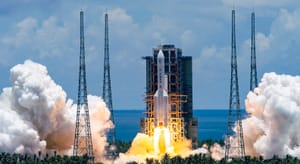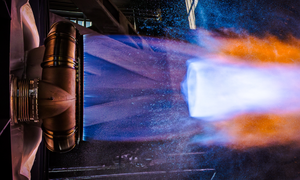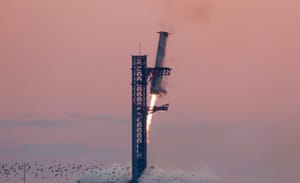
Apr 2, 2024
Astra's impressively awful flight history
Disclaimer: All currency is in United States Dollars unless stated otherwise.
Astra was arguably one of the most prolific small payload launchers a few years ago, however for the past two years they've been stuck on the ground. While stuck on the ground they've faced no shortage of problems too.
Astra was formerly one of the most valued publically traded aerospace companies with a valuation of over two billion dollars in February 2021. By March of 2024 their valuation had fallen to twenty-three million dollars, the company was taken private in the same month with its value falling again to a little over eleven million dollars.
The company had formerly claimed to be able to scale up to three-hundred launches per year at a 'low-cost'. Evidently, the company never scaled to that flight rate with Chris Kemp on record saying:
“I think what Astra has to do, really, is we have to have so many launches nobody thinks about it anymore.”
Kemp, Astra's current Chief Executive Officer, had been hoping that their launch vehicles unreliability would have been overshadowed by their flight rate. According to Tech Crunch, they hoped to gain a share in the launch market via 'low-cost' and 'high-volume' launches.
The company's failure to reach the cadence also caused problems for customers looking to fly on Rocket 3. Rocket 3 is rumored to have cost as low as 2.5 million dollars for launch, however it could have cost as much as SpaceX's Falcon 9, which is approximately 55 million dollars, once spacecraft insurance was included.
Astra has pretty clearly seen the errors of this approach with its new vehicle, Rocket 4, being focused on reliability. Rocket 4 will have Astra source the engines externally from Firefly Aerospace, for the first-stage, and Ursa Major, for the second-stage. However, the company has removed most mentions to Rocket 4 from its site, excluding its news tab, which was announced in August of 2022.

Rocket 4 would have been 18.9 meters tall and 1.8 meters in diameter, its fuels would have been rocket-grade kerosene and liquid oxygen. The first-stage would have been powered by two Chrion engines, which are modified Reaver engines from Firefly Aerospace, to generate 31.6 tons of thrust. The second-stage would have been powered by a single Hadley engine, from Ursa Major, to generate 2.9 tons of thrust. Astra claimed the payload capacity of Rocket 4 would be 550 kilograms to low Earth orbit.
Recent footage leaks of an explosion in March of 2020 via Tech Crunch's Aria Alamalhodaei has had the conversation around Astra online start-up once again.

With the focus back on Astra and its questionable future, I believe its time to look back at its flight history so far.
Authors Note: Astra was formerly called 'Stealth Space Company' in the media and shared very few details, details on early flights are scarce.
Flight One - July 20th 2018
The flight of Astra's first rocket is somewhat unknown with it reportedly being a suborbital flight for a commercial customer. Astra claims that the rocket didn't have a functioning second-stage and was intended to be suborbital.
The mission is believed to have been a failure with details being hard to find, Astra claims the flight was a success for the company.
Flight Two - November 29th 2018

The flight plan for Astra's second flight was similar to its first with a commercial customer believed to be onboard for a suborbital flight. Astra claimed that the second flight had a second-stage 'simulator' onboard for the flight.
The flight was reportedly very short with all five engines experiencing a failure, leading to the rocket falling back towards land. All debris from the launch reportedly fell inside the Pacific Spaceport Complex and caused no harm.
Astra once again claimed the flight was a success.
Flight Three - March 23rd 2020

Astra does not consider what happened on the 23rd of March 2020 a flight but was attempting to launch for DARPA earlier the same month before failing to complete their launch challenge. The official word on what happened on the 23rd was an 'anomaly' at the launch pad leading to loss of the vehicle.
It had been rumored that a fire broke out at the launch pad previously. With new footage of what happened on the 23rd, high-pressure helium was likely transferred from the second-stage to the first-stage causing the tank to overpressurise and explode, this was detailed further in the book When the Heavens Went on Sale by Ashlee Vance. Astra has not commented on the release of footage from Tech Crunch.
Officials of the Pacific Spaceport Complex requested, via local media, that the public not approach the launch site in the days following the explosion.
Flight Four - September 12th 2020
Volume up! Rocket 3.1's orbital launch attempt pic.twitter.com/nm1bDewdl5
— Astra (@Astra) September 12, 2020
Liftoff of Astra's fourth flight via Astra on X.
Astra's fourth flight was its first orbital launch attempt to leave the ground under the power of its engines. The rocket was carrying no payloads onboard, but was part of a series of three rockets that were part of the company's effort to reach low Earth orbit.
The flight ended in a similar fashion to Astra's second flight, with all five of the engines shutting down a believed thirty seconds into flight. The cause of the shutdown was believed to be due the guidance system introducing unplanned roll oscillations. All debris reportedly fell inside the Pacific Spaceport Complex and caused no harm.
Flight Five - December 15th 2020

On their fifth flight, Astra passed the Kármán line and entered space for the first time. The second-stage reached the targeted altitude for the mission but failed to enter orbit. The failure was attributed to an issue with the propellant mixture ratio in the second-stage engine, causing it to run out of fuel before achieving orbital speed.
The rocket carried no payload onboard, like the previous flight. Due to the speed of the second-stage, it was destroyed upon re-entering the upper atmosphere.
Astra considered the flight a success, adding that it was a major step towards orbit.
Flight Six - August 28th 2021
Reviewing flight data and video, two things are very clear - 1) An engine shut down right after launch 2) Everything that happened next made me incredibly proud of our team. Space may be hard, but like this rocket, we are not giving up. #AdAstra pic.twitter.com/2g3n812EaW
— Chris Kemp (@Kemp) August 29, 2021
'Liftoff' of Astra's sixth flight via Chris Kemp on X
The sixth flight for Astra had one of the more peculiar failures in launch history. Shortly after liftoff, an engine appeared to fail causing the rocket to 'powerslide' away from the launchpad.
The cause of the failure was believed to be caused by a leak in the rocket's fueling system, which led to the engine failing under a second into flight. The rocket was reportedly terminated two and a half minutes later after it left its intended flight path.
The rocket had the United States Space Force STP-27AD1 payload onboard, it was destroyed along with the rocket.
Flight Seven - November 20th 2021
Orbit. ✅ Astra successfully completed its first commercial orbital launch for the @SpaceForceDoD late Friday night, November 19, 2021, PST: https://t.co/FakPzAvfxI #AdAstra pic.twitter.com/icWXvAKjAn
— Astra (@Astra) November 22, 2021
A recap video of Astra's seventh flight via Astra on X
Astra's first undisputed success was on its seventh flight when it carried the STP-27AD2 payload into a 500-kilometer 86-degree orbit for the United States Space Force.
The rocket is believed to have had all systems function as planned during the launch. No payload was physically separated as STP-27AD2 was a signal-simulating payload.
Flight Eight - February 10th 2022

Three months after Astra's first successful flight to low Earth orbit their rocket failed again. The failure was in the second-stage of the vehicle with a flaw in the thrust vector system, a wiring error in the separation mechanism was also found.
Astra was carrying four satellites as part of NASA's Educational Launch of Nanosatellites initiative. The four satellites were: Ionospheric Neutron Content Analyzer (INCA) from New Mexico State University, the BAMA-1 technology demonstrator from the University of Alabama, QubeSat from the University of California, and R5-S1 from the Johnson Space Center.
Astra claimed to have 'upgraded' their systems onboard the rocket to make it more resilient in the future in case of a similar failure.
Flight Nine - March 15th 2022
Astra successfully deployed our first customer payloads for @SpaceflightInc on Spaceflight's Astra-1 mission. #AdAstra pic.twitter.com/OnTitxcs7R
— Astra (@Astra) March 16, 2022
A recap of Astra's ninth flight via Astra on X
A little over a month later, Astra returned to flight carrying eighteen payloads into a sun-synchronus orbit as part of a rideshare mission for Spaceflight Inc. The rocket is believed to have had all systems function as planned during the launch with all but one payload deploying from the rocket, the payload that was not deployed was intended to stay onboard.
Flight Ten - June 12th 2022
Astra's last flight to date was another failure for the company. The failure was believed to once again be related to the second-stage with it reportedly tumbling four minutes into its burn. According to Astra, the rocket also failed to reach orbit, leaving the payloads unusable.
Onboard the tenth flight were two Time-Resolved Observations of Precipitation structure and storm Intensity with a Constellation of Smallsats, or TROPICS, satellites which were from NASA.
Conclusion
So far Astra has attempted ten flights across four years with only two being clear successes. Astra is still hoping to come back to the launch industry in 2024 but it's unclear if they will manage to launch this year. Progress updates on Rocket 4 however have been few and far apart.
It's also unclear how long the company will last and if they will manage to launch againWith the company going private regular updates on the company's finances and stability are unlikely to be public.
Who is Astra?
Astra is an American rocket company based in Alameda, California. The company was founded in October of 2016 and successfully made it to orbit in November of 2021, making it the fastest a company has gone from founding to orbit in the United States.



